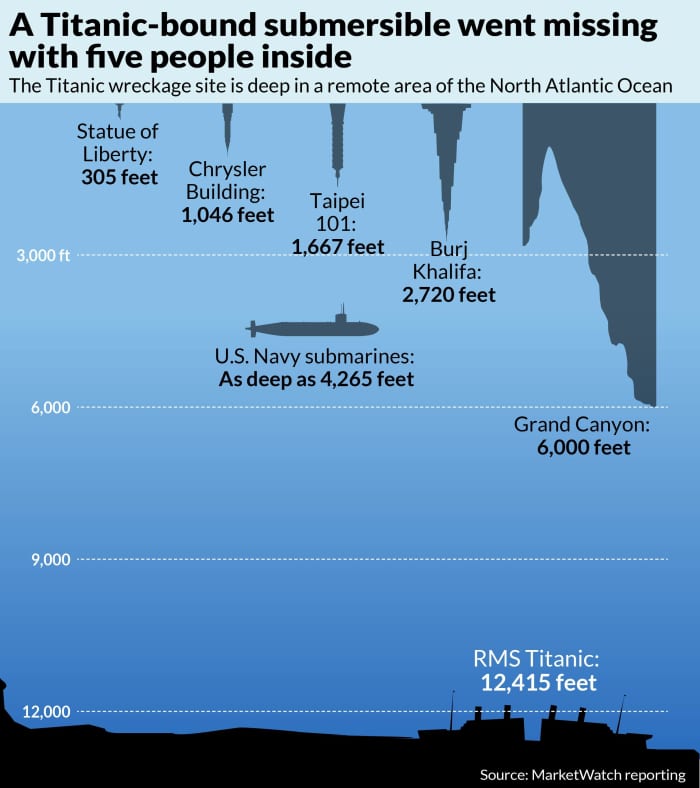This post was originally published on this site
The United States Coast Guard is still searching for the small underwater vessel that went missing on Sunday morning as it was descending to see the wreckage of the Titanic, which sank in 1912. There has been no reported contact from the passengers inside the vessel as of Tuesday morning.
The wreckage site, located in a remote area of the North Atlantic Ocean, has been visited annually by OceanGate Expeditions for the last three years. Here’s what we know about the missing submersible and who was on board so far.
When did the vessel go missing?
The vessel, named Titan, was launched from a hired Canadian research icebreaker, Polar Prince, on Sunday morning. The dives were part of an eight-day, seven-night package.
The submersible went missing on Sunday morning, and was unable to communicate with the surface world roughly an hour and 45 minutes later after it began its descent, the Coast Guard said.

The underwater vessel has gone missing with five people inside.
Who was aboard the vessel?
The Coast Guard said there was one pilot aboard plus four “mission specialists,” or passengers who paid to go on the OceanGate Expeditions journey.
One of the passengers was British businessman Hamish Harding, according to Action Aviation, where Harding serves as chairman. Harding holds three Guinness World Records and flew on a 2022 Blue Origin flight to space.
Shahzada Dawood and his son Suleman, members of a prominent and wealthy Pakistan family, were also on board. “We are very grateful for the concern being shown by our colleagues and friends and would like to request everyone to pray for their safety while granting the family privacy at this time,” the Dawood family wrote in a statement to the Associated Press.
The fourth mission specialist is former French Navy officer Paul-Henry Nargeolet. He is considered a Titanic expert and has completed 37 successful journey’s to the ship’s wreck site, as well as leading the first recovery expedition to the Titanic in 1987.
Nargeolet’s presence on the vessel was first reported by David Gallo, a senior adviser for strategic initiatives and special projects at RMS Titanic.
How much did the trip cost?
This OceanGate Expedition costs $250,000 per person, according to an archived version of the company’s website, not including the cost of personal travel. No diving experience is necessary to book the trip, the website said, but it’s “helpful to have a sturdy pair of sea legs.”
What was the Titan’s mission?
The aim of the Titan’s expedition was to chronicle the deterioration of the Titanic and the ecosystem around it.
The remains of the Titanic are decaying partially due to a metal-eating bacteria named Halomonas titanicae, according to the Smithsonian.
How deep is the Titanic wreckage?
When the Titanic sank after hitting an iceberg during its 1912 maiden voyage, roughly 1,500 people died. The remnants of the massive ship are about 2.4 miles (about 12,000 feet) below the surface.
At the Titanic’s wreck site about 2.4 miles below the surface, the water pressure is about 400 atmospheres, which is like having 35 elephants on top of your head, OceanGate posted about its trip.

The Titan submersible was journeying to the Titanic, which is about 2.4 miles below the surface.
Can the people inside the vessel survive without outside communication?
David Concannon, an adviser to OceanGate, said the submersible had a 96-hour oxygen supply starting at roughly 6 a.m. Sunday. He added officials were working to get a remotely controlled vehicle that can dive to a depth of about 20,000 feet to the site as soon as possible.
Assuming the submersible stays under water, the oxygen supply would run out on Thursday morning, according to Concannon’s projections.
What is a submersible?
A submersible is an underwater craft that is typically used for scientific analysis.
Unlike submarines that leave and return to port under their own power, submersibles require a ship to launch and recover them. OceanGate hired Canadian research icebreaker Polar Prince as a support vessel for the expedition.
What are rescuers saying?
U.S. Coast Guard commander Rear Adm. John Mauger, said more rescue resources would arrive in the coming days.
“It is a remote area — and it is a challenge to conduct a search in that remote area,” he said. “But we are deploying all available assets to make sure we can locate the craft and rescue the people on board.”

